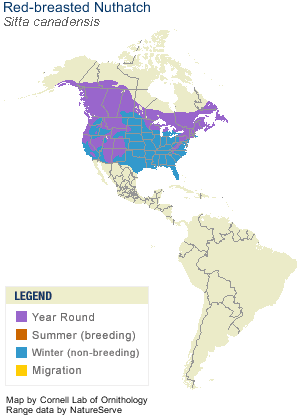Physical Description
Adult Red-breasted Nuthatches have gray backs with rust-colored breasts and undertail coverts. They have black caps and white eyebrows. Females are less colorful, with a more washed-out rust color on the belly.
Young birds resemble the adults, but their colors are dull in comparison; particularly the black portions of the head. There are faint black edgings on the back, and the white on the eyebrow, chin, and sides of the head is speckled with black. The underparts are pinkish-buff, deepening to cinnamon on the crissum, the area around the cloacal opening.
Distribution and Breeding Habitat
Red-breasted Nuthatches inhabit northern and subalpine habitats. They are found in the southern half of Canada and in the western and northeastern regions of the United States. Ideal breeding habitat consists of mature, partly open coniferous or mixed coniferous-deciduous forests. Red-breasted Nuthatches nest in aspen, birch, oak, cottonwood, and poplar trees, as well as in spruce and other cone-bearing trees.

Diet
As they move along the trunks and branches of trees, Red-breasted Nuthatches glean invertebrates such as beetles, pine woodborers, and spiders. In winter, they relish the seeds of fir, pine, and spruce trees, and they are often found feeding in areas where these trees have seeded abundantly the previous season. They are also common visitors at sunflower and suet feeders in woodland settings.
Pair Formation and Territoriality
Red-breasted Nuthatches are monogamous. Pairs will remain together on their feeding territory if the cone crop has been good, or alternately, if they are close to a feeding station. Courtship displays are usually carried out among the branches and tops of coniferous trees, where the birds are difficult to observe.
Nesting Behavior
Nest Building: The breeding season begins in late April or early May. Both adults work to excavate a nest cavity, most commonly in a rotten stub or branch of a dead tree. Nest boxes are occasionally used. The average height of the nest is 15 feet off the ground. The nest is made of grass, rootlets, moss, shredded bark, plant fibers, hair, and fur. Some nuthatches can complete a nest and lay an egg within a week; others require more than two weeks to finish their nests.
Adults typically smear tree pitch around the entrance of their nest cavity, even on a nest box. The pitch, as a rule, is generously laid on, sometimes for a distance of several inches all around the hole. This activity, which is carried on throughout the nesting period, is thought to deter insects, small mammals, and other birds from entering the nest cavity. Several observers have noted that Red-breasted Nuthatches have a habit of flying straight into the entrance hole, without alighting on the outside of the cavity first, perhaps to avoid the pitch smeared around the hole.
Egg Laying: Clutch sizes range from four to seven eggs, with five or six being the usual number. The non-glossy eggs are white or pinkish-white, speckled with brown, reddish-brown, and lavender.
Incubation: The incubation period of the Red-breasted Nuthatch is generally believed to be 12 days; one source reports 15 to 16 days. Incubation is probably done by the female alone.
Nestling Care: Both adults tend the nestlings. Discrepancies exist as to the length of time the nestlings spend in the nest. A general range is 18 to 21 days, but one source reports 14 days. The number of broods produced in one breeding season and whether this species produces replacement broods are unknown.
Winter Movement and Dispersal
Unlike other nuthatches, Red-breasted Nuthatches do not always remain on their territories year round. They may move southward in the fall, or they may remain in the north throughout the winter, depending on the state of the cone crop.
There is no information on juvenile dispersal.